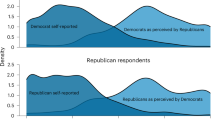Abstract
In almost all democratic national elections an individual vote cannot change the election outcome. The fact that many individuals nevertheless participate voluntarily in such elections suggests that people do care about democracy as such. This experiment investigates the value of democratic voting rights by providing participants the chance to sell them. More specifically, an incentive compatible mechanism is used to elicit the willingness-to-accept value of the voting right in the election of the German Bundestag on 16 October 1994. A postexperimental questionnaire makes it possible to assess the relative importance of answers to the frequently raised question: Why do people vote?
Similar content being viewed by others
References
Akerlof, G.A. and Dickens, W.T. (1982). The economic consequences of cognitive dissonance. American Economic Review 72(June): 307-319.
Barzel, V. and Silberberg, E. (1973). Is the act of voting rational? Public Choice 16(Fall): 51-58.
Becker, G., de Groot, M.H. and Marshak, J. (1963). An experimental study of some stochastic models for wagers. Behavioral Science 8: 199-202.
Downs, A. (1957). An economic theory of democracy. New York: Harper & Row.
Ferejohn, J.A. and Fiorina, M.P. (1974). The paradox of not voting: A decision-theoretic analysis. American Political Science Review 68: 525-536.
Ferejohn, J.A. and Fiorina, M.P. (1975). Closeness counts only in horseshoes and dancing. American Political Science Review 69: 920-925.
Festinger, L. (1957). A theory of cognitive dissonance. Evanslon, IL: Roar.
Fiorina, M.P. (1976). The voting decision: Instrumental and expressive aspects. Journal of Politics 38: 390-413.
Guttman, J.M., Hilger, N. and Shachmurove, Y. (1994). Voting as investment vs. voting as consumption: New evidence. Kyklos 47: 197-207.
Harsanyi, J.C. (1979). Bayesian decision theory, rule utilitarism, and Arrow's impossibility theorem. Theory and Decision 11: 289-317.
Kant, I. (1785). Groundwork of the metaphysics of morals. Translated and analysed by P.J. Paton. New York: Harper & Row, 1964.
Kirchgässner, G. (1992). Towards a theory of low-cost decisions. European Journal of Political Economy 8: 305-320.
Kliemt, H. (1986). The veil of insignificance. European Journal of Political Economy 2/3: 333-344.
Kruse, H., Berg, E. and Weber, M. (1993). Erklären unternehmensspezifische Faktoren den Kursunterschied von Stamm-und Vorzugsaktien? Zeitschrift für Bankrecht und Bankwirtschaft 5: 23-31.
Mueller, D.C. (1989). Public choice II. 2nd ed. Cambridge, MA: Cambridge University Press.
Nannestad, P. and Paldam, M. (1994). The VP-function: A survey of the literature on vote and popularity after 25 years. Public Choice 79: 213-245.
Quattrone, G.A. and Tversky, A. (1985). Self-deception and the voter's illusion. In J. Elster (Ed.), The multiple self, 35-58. Cambridge, MA: Cambridge University Press.
Riker, W.H. and Ordeshook, P.C. (1968). A theory of the calculus of voting. American Political Science Review 62: 25-42.
Römer, A.U. (1991). Der kontingente Bewertungsansatz: Eine geeignete Methode zur Bewertung umweltverbessernder Maßnahmen? Zeitschrift für Umweltpolitik und Umweltrecht 4: 411-456.
Schram, A.J.H.C. (1991). Voter behavior in economic perspective. Berlin: Springer-Verlag.
Schram, A. and Sonnemans, J. (1996a). Voter turnout as a participation game: An experimental investigation. International Journal of Game Theory 25: 385-406.
Schram, A. and Sonnemans, J. (1996b). Why people vote: Experimental evidence. Journal of Economic Psychology 17: 417-442.
Schram, A. and van Winden, F. (1994). Why people vote: The role of inter-and intragroup interaction in the turnout decision. In H. Brandstätter and W. Güth (Eds.), Essays on Economic Psychology. 213-250. Berlin: Springer-Verlag.
Stigler, G. (1972). Economic competition and political competition. Public Choice 13(Fall): 91-106.
Struthers, J. and Young, A. (1989). Economics of voting: Theories and evidence. Journal of Economic Studies 16/5: 1-42.
Tullock, G. (1967). Toward mathematics of politics. Ann Arbor: University of Michigan Press.
Weber, M., Berg, E. and Kruse, H. (1992). Kurs-und Renditevergleich von Stamm-und Vorzugsaktien - Eine empirischeAnalyse. Zeitschrift für betriebswirtschaftlicheForschung 44/6: 548-565.
Author information
Authors and Affiliations
Rights and permissions
About this article
Cite this article
Güth, W., Weck-Hannemann, H. Do people care about democracy? An experiment exploring the value of voting rights. Public Choice 91, 27–47 (1997). https://doi.org/10.1023/A:1004972900845
Issue Date:
DOI: https://doi.org/10.1023/A:1004972900845




